Lhasa Apso is a small but very charismatic native of Tibet; a representative of one of the oldest dog breeds, with a glamorous appearance and an independent character.
Lhasa Apso is a self-sufficient intellectual, a loyal companion, and a creepy owner with the courage of a shepherd dog and the appearance of a soft toy. Sly and in many respects independent, this “Tibetan” will easily pick up the key to the master’s heart, and if allowed, he will gladly begin to lead all family members. However, if you do not delay and manage to besiege the shaggy usurper in time, relations with him can go according to a different scenario – from properly educated Lhasa apso, wonderful watchmen, as well as no less sensitive human friends, turn out.
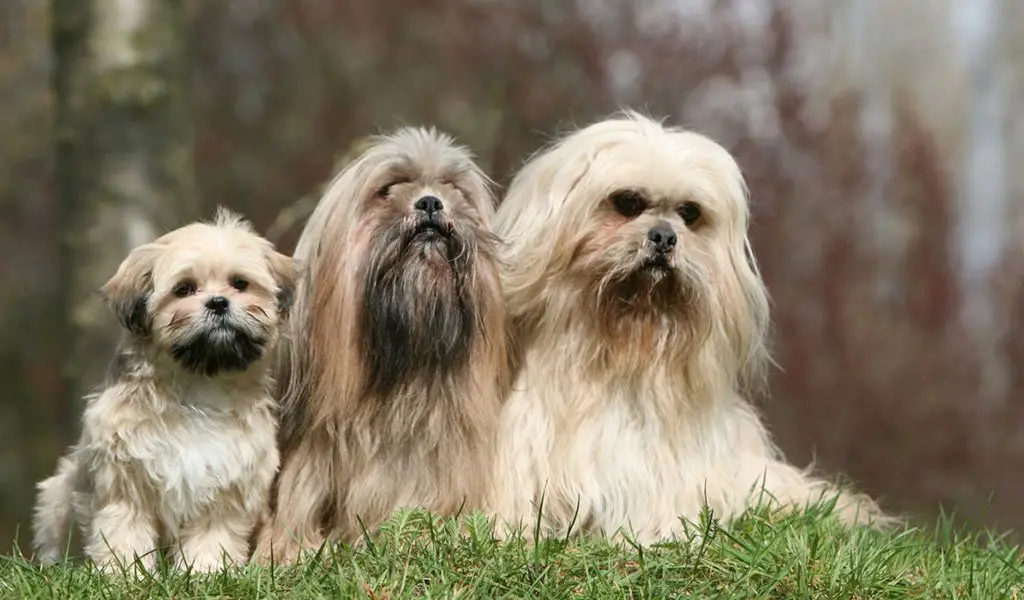
The birthplace of the breed is Tibet, or rather, its monasteries, whose inhabitants were not indifferent to small dogs, famous for their strong-willed character and sociability. It is known, for example, that the gates of Buddhist monasteries were always guarded by Tibetan mastiffs, while the status of the guardians of the Dalai Lamas’ quarters belonged entirely to the Lhasa apsos. Local beliefs also helped to maintain the breed’s image. According to them, the souls of their dead owners entered the bodies of animals, thus continuing their earthly path.
In praising the breed, the Tibetans went so far as to classify its representatives as sacred animals, the sale of which was severely punished. Sometimes Lhasa apso was still given, but such offerings were made in exceptional cases and almost always not to Europeans. That is why dogs came to the Old World only by the end of the 19th century.
An interesting fact: in their homeland, the Lhasa Apso breed was often called dining admirers. It was believed that Buddhist monks specifically taught dogs to sigh in sorrow to pity the believers. Those interested in the reason for the strange sobbing of animals were explained that the dog had not eaten for a long time, but education does not allow him to whine and beg for alms. It is clear that after such stories, the number of monastic donations increased sharply.
The British were the first to get acquainted with Lhasa Apso, but at first various types of individuals were imported into the country, among which there were animals up to 50 cm in height. It was decided to divide shaggy dogs into breeds in England only in the 30s. After that, the larger dogs were called Tibetan Terriers, and the smaller ones, Lhasa Apso. Dogs of the Dalai Lamas got to the rest of Europe later. For example, breeders in Germany saw the breed in the late 30s, the French in the middle of the 20th century. The “Tibetans” reached the United States by the end of the 50s, and not without adventures: at first, the Americans did not see the difference between the Shih Tzu and Lhasa Apso breeds, mistakenly combining them into one type. United States dog handlers managed to separate both canine clans from each other only by 1969.
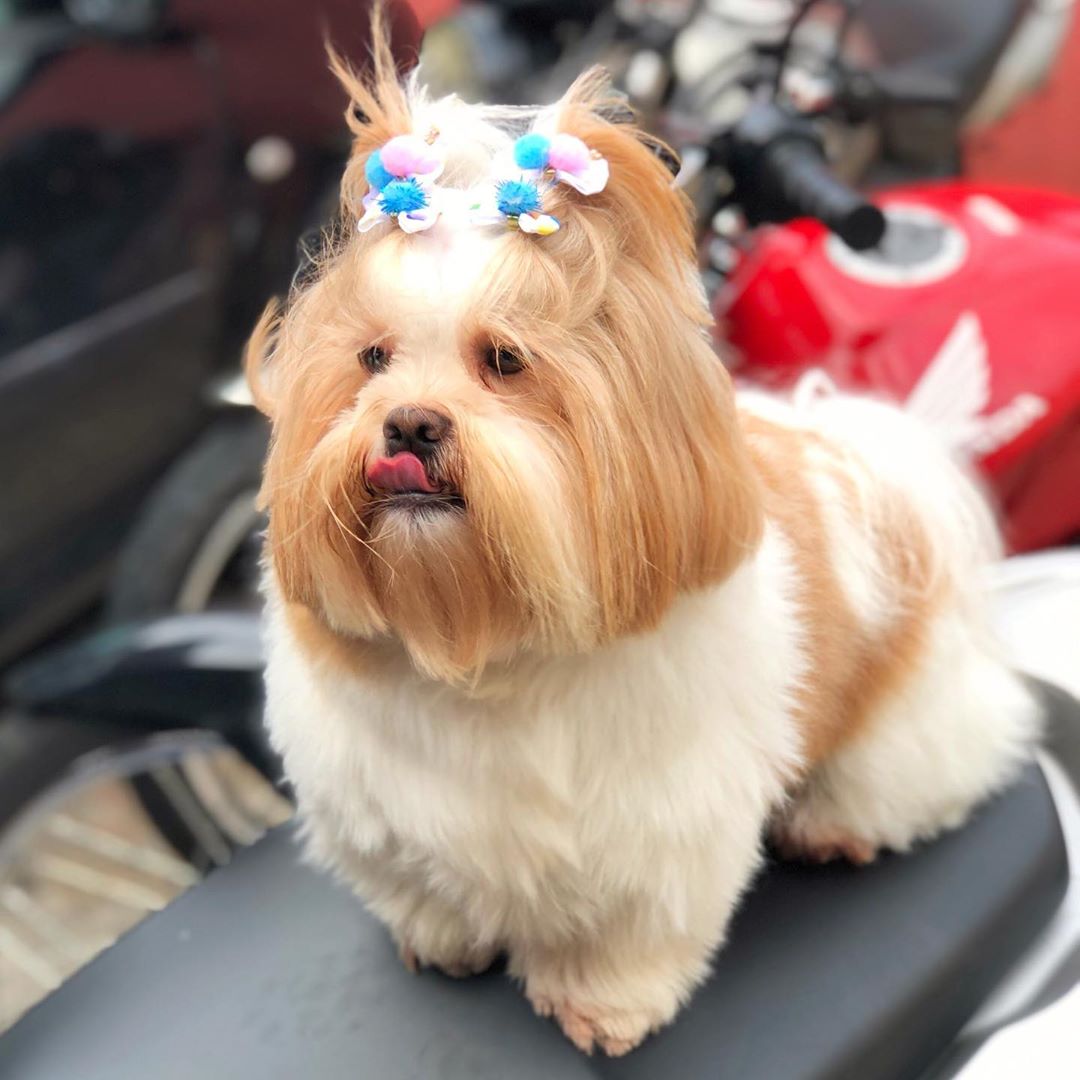
The Tibetan Apso today is a short, sturdy man, and also the owner of ultra-long bangs, wrapped in a mantle of heavy, coarse wool. It is impossible not to note the strong external similarity of these dogs with their probable congeners – the Shih Tzu. However, if you put the breeds side by side, the contrast between their representatives will be brighter. The fact is that Lhasa apso is much larger than its relative, and also has a longer muzzle. The optimal height for a Tibetan male is 25-25.4 cm. In general, the height at the withers is considered acceptable if it does not exceed 27.3 cm. Females are usually shorter and lighter than dogs. If a male Lhasa Apso can weigh from 6.4 to 8.2 kg, then for “girls” the upper limit is 6.4 kg.
The dog’s skull is rather narrow, but not domed or flat, with a shallow transition. The muzzle with a flat back is approximately 4 cm long, which is ⅓ of the length of the head. The head of the animal is covered with luxurious decorating hair that forms glamorous bangs, mustache, and goatee. The hair on the forehead falls over the eyes but does not interfere with the view.
The color of the nose is black.
The standard type of bite for the Lhasa apso is a reverse undershot (always without retreat). The outer side of the incisors of the upper jaw touches the inner side of the lower incisor teeth, forming the so-called reverse scissors bow. In this case, the incisal line should be as wide and straight as possible. All teeth should be preserved in the animal (complete dental formula).
The harmoniously developed eyes of the Lhasa apso are of normal size, neither bulging nor deep set. The incision of the eyelids is usually oval, with the eyeballs set straight. An important condition: that the whites of the eyes are not visible either from above or in the area of the lower eyelid.
For dogs of this breed, the hanging position of the ear canal is characteristic. The hair on this part of the body is thick, evenly covering the skin.
The neck should have a strong bend and still look powerful.
The body of the Lhasa Apso is strong, compact in build, with an even topline and a hardy loin. The ribs are strongly extended backward.
The dog’s movements are characterized by lightness and freedom. Forelegs with sloping shoulder blades and straight forearms. The hind limbs are distinguished by strong muscles and pronounced angles of the articular joints. The hock joints are located almost parallel, but at the same time, they are distant from each other, which can be seen when viewed from the back of the animal. Like the body, the legs are hidden under the abundant hair.
Typical features for the Lhasa Apso breed are a high tail set, as well as its position above the back, without curling into a ring. Acceptable if the tip of the tail is hooked.
Warm “fur coats” of Lhasa apsos are the result of adaptation to the harsh temperature conditions of Tibet. The topcoat grows long, coarse, and devoid of silkiness. The undercoat is moderate, but soft, with good air and warmth retention. The dog’s coat does not interfere with its movement.
Lhasa apso can be of any suit. The most typical colors are golden, brown, black, white, dark gray, honey, two-tone, sand, smoky, bluish-gray.
Lhasa apso can only be excluded from participation in the exhibition for conspicuous exterior flaws and deformities. Individuals with cryptorchidism, cowardly, showing aggression towards people, as well as dogs whose height exceeds 30 cm, do not pass the qualifying round.
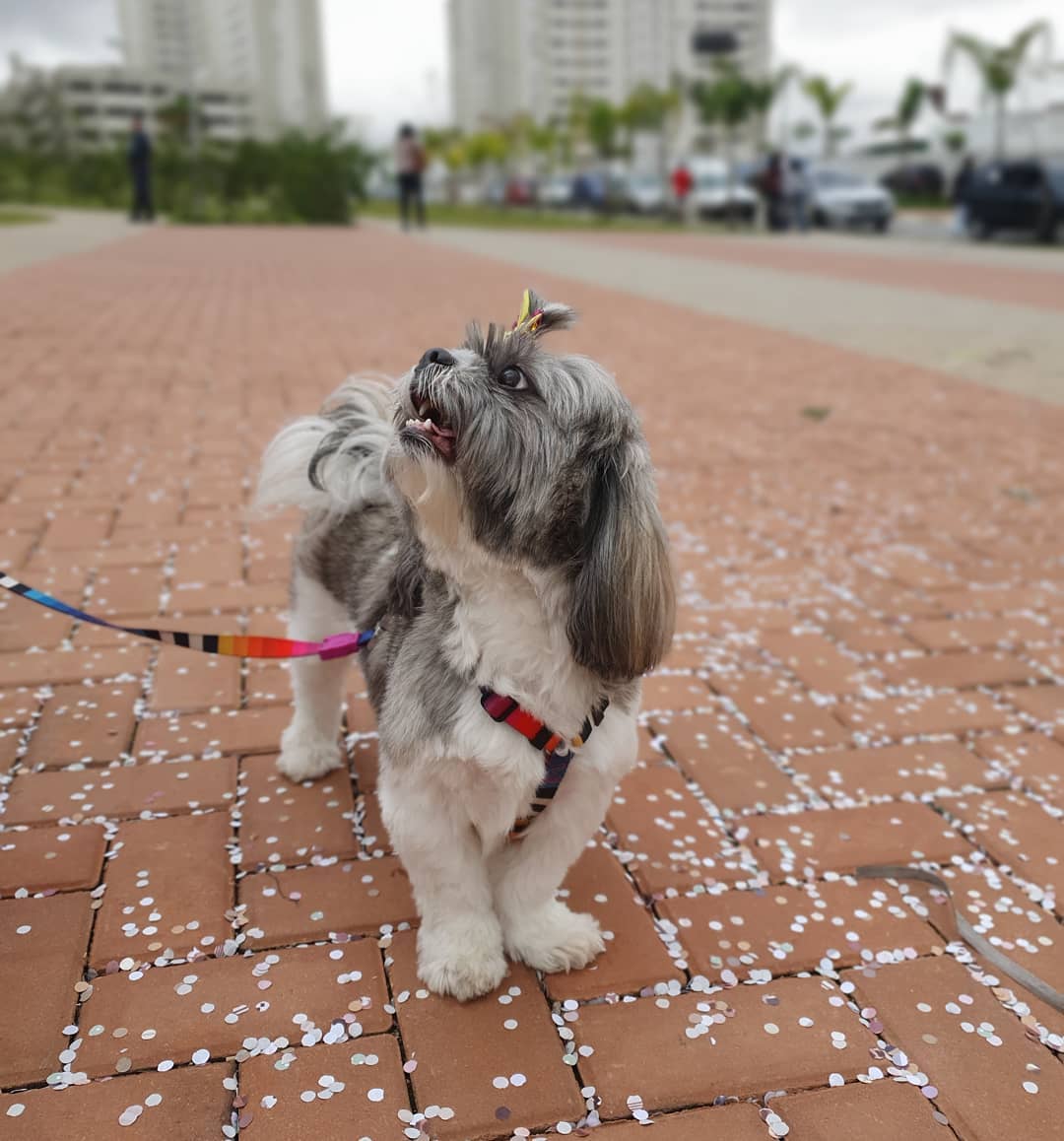
The appearance of the breed does not at all reflect the characteristics of the character of its representatives, so if you expect that Lhasa Apso will be something in between a sofa cushion and a children’s toy, then you are mistaken. By nature, small “Tibetans” are closer to shepherd dogs than to decorative tribesmen. Hence – the incredible loyalty to the owner, distrust of outsiders, and the desire to take patronage over all two-legged creatures that come into sight.
Lhasa apsos are very attached to people but do not stoop to harassing and annoying following on the heels of the owner. With children, the breed does not exactly do not get along, rather it does not consider it necessary to pamper little mischievous people with its attention and patience. Possessing a developed possessive instinct, Lhasa Apso is jealous of the fact that children encroach on his toys and territory. By the way, most of the funny conflicts between these two clans occur precisely because of the unwillingness to give in to each other. For example, a dog fiercely defends property, children continue to try to steal a ball from an animal, and as a result, the relationship between the “tail” and young bullies turns into a state of permanent confrontation in the style of “who will beat whom”.
If Lhasa Apso puts the kids on a step lower than himself, then he prefers to be friends with adolescents on an equal footing. For this reason, it is undesirable to entrust the training of the dog to the younger members of the family – the “Tibetan” will not obey such teachers. Lhasa Apso is selective in expressing feelings of affection, therefore, it always appoints one person as to its own master. The lack of hypertrophied hunting qualities helps the dog to get along with other small pets, while not forgetting to show that she is the “number one” in the apartment anyway.
Living in the same territory with larger tribesmen for a “Tibetan” is not a tragedy if the owner made at least a minimum of an effort to make friends with the dogs. Of course, from time to time, the pet will include a greedy man, grumbling at anyone who touched his bed, bowl, or toys, but such behaviors are not corrected. Conflicts with the use of claws and teeth are also not excluded, although not all individuals condescend to a brutal showdown. At the same time, dog handlers claim that the grip of the Dalai Lama dogs is not weaker than that of a pit bull, which makes it incredibly difficult to separate the grappling “tails”.
Lhasa Apso is a playful dog that understands humor and willingly participates in a variety of practical jokes. However, animals demonstrate all these qualities of their own free will and never – at the whim of the owner. So if you need a pet with the makings of a clown, the Lhasa Apso is not the breed that will make your dreams come true.
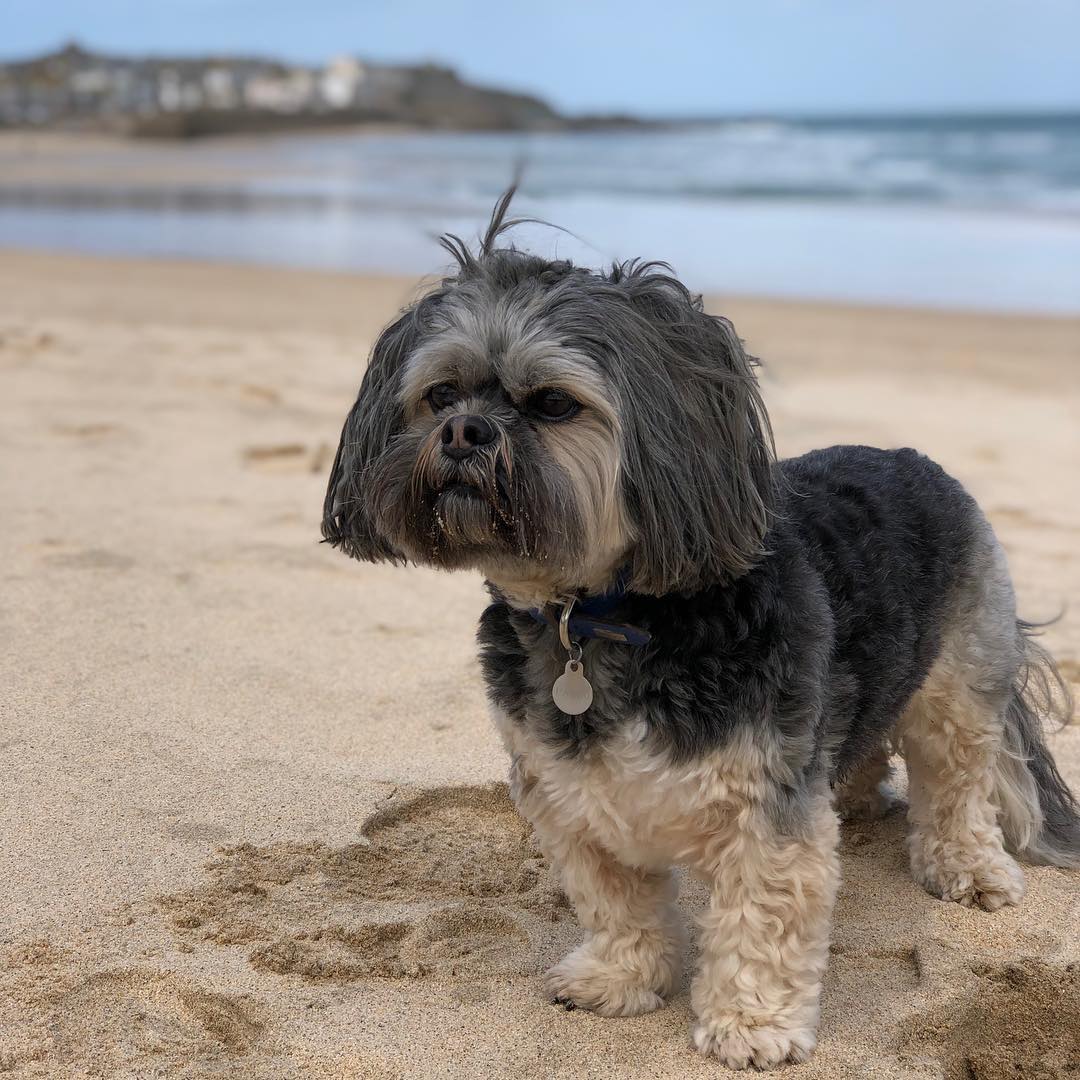
Lhasa Apso is smart and quick-witted dogs, but the innate desire to lead, and, if possible, suppress, makes them not the most diligent students. At the same time, it is vital to socialize, educate and train the breed, because a “Tibetan” who has not been instilled in norms of behavior is still impudent. And of course, in no case indulge the animal, so that it does not develop the so-called small dog syndrome, which manifests itself in pampering and uncontrollable antics.
When raising a puppy, always pay attention to behavior correction. Stop the dog’s attempts to bite you, do not pick up the barking dog in your arms to comfort you, do not avoid meeting other, larger “tails”. Lhasa apso must understand that for the owner he is not the center of the universe, but only a junior comrade.
The breed does not work under duress, which greatly complicates the training process, so organize your activities so that the Lhasa Apso can get carried away. Do not give a command unless you are sure the puppy will not obey it. Always set achievable goals and encourage your pet to take action. Remember: good or bad, but the animal must fulfill the requirement. This approach is disciplined and does not allow the pet to think that a person’s orders can be circumvented.
Positive reinforcements in the learning process are required, while do not seek to feed the “Tibetan” with delicacies so that in the future he does not lose interest in the usual diet. But punishments will have to be applied with extreme caution. The fact is that Lhasa Apso will never allow himself to be humiliated. As an example: the dog will certainly snap at any shout and will perceive the waving of his hand as a final undermining of trust.
To convince a pet that he is wrong, a strict reprimand in an even, non-ingratiating tone is enough. In extreme cases, the shaggy discipline breaker can be flicked on the nose with a fingernail or newspaper. Do not use a leash for the physical impact: having received a strap along with the sirloin parts, Lhasa Apso will simply refuse to walk on a harness, because it will cause negative associations.
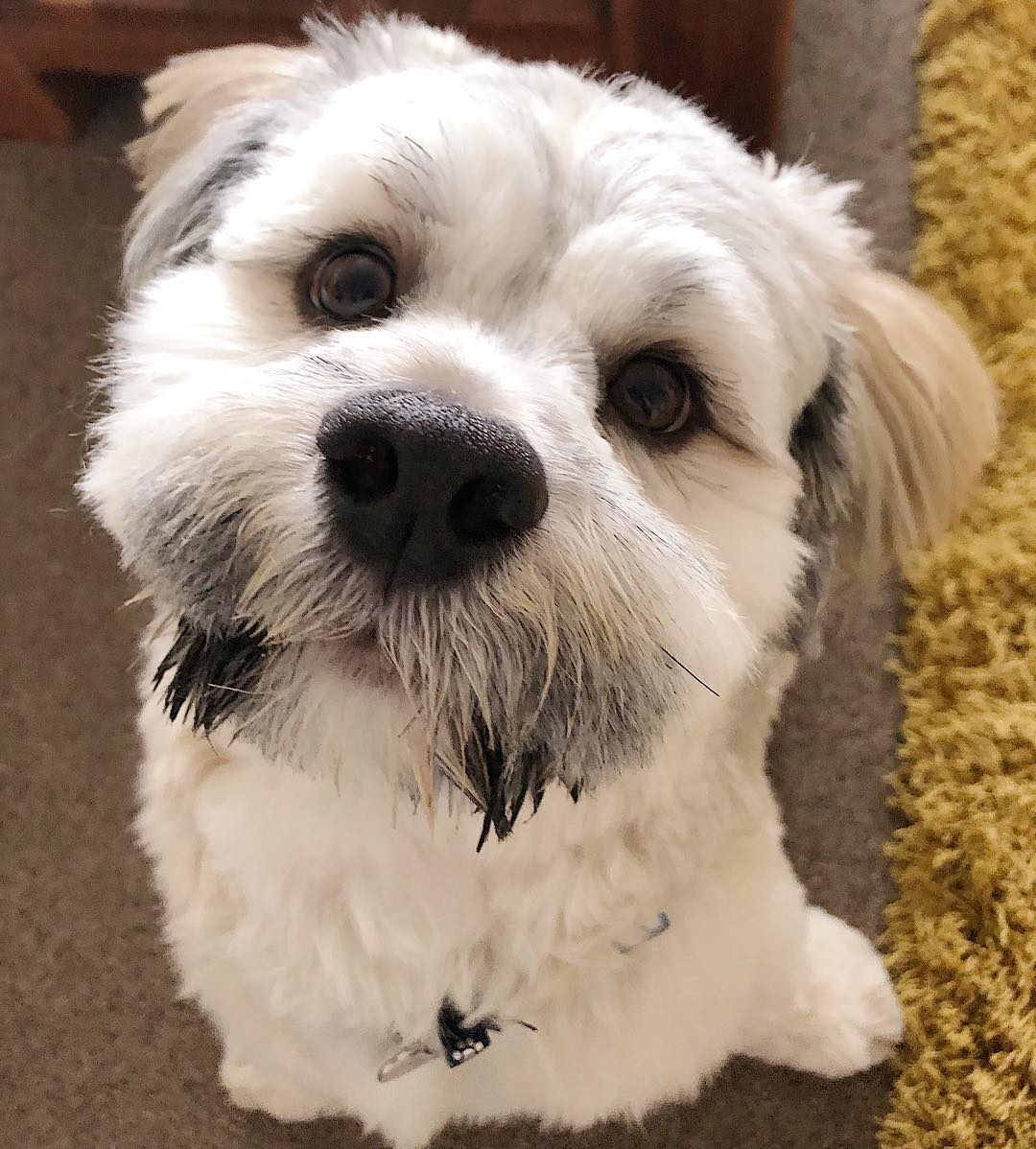
Like any decorative pet, Lhasa Apso loves comfort. In addition, he is a big owner, therefore, for the dog to feel as free as possible in the house, it needs property – toys, a bed, bowls for food and water. The Lhasa apso prefers to own all these belongings alone, fiercely barking at those encroaching on his wealth.
Shaggy “Tibetans” are not hyperactive, but they like to take a walk, so 1-2 times a day the ward should be taken to the promenade. At home, it is recommended to provide a pet with a tray. Lhasa Apso has a small bladder volume, they simply cannot endure with a toilet before walking.
The main advantage of Lhasa Apso wool is that it is odorless. Even if the animal had to skip the planned bathing, its hair will not ooze canine “amber”. But you will have to work hard to maintain the effective appearance of the dog, but you need to prepare for this nuance before buying a puppy, Lhasa Apso is not a breed for the lazy.
The coat of the dogs is heavy and coarse. The undercoat is not very abundant, but this does not prevent it from forming mats, so the animal needs to be combed daily. There is a special variety of the breed, whose representatives have a too developed undercoat that cannot be disassembled with a comb. Such individuals are sheared, although, according to the generally accepted rule, radical shortening of the breed’s coat is contraindicated.
Train the Lhasa Apso to groom from an early age: dogs do not respect such procedures, which they remind the owner of with whining, attempts to bite the hand, and other unpleasant tricks. Representatives of this breed are always combed according to the growth of the coat, forming an even parting in the middle of the back. The bangs over the eyes, from the age of 3 months, are pulled together with rubber bands in two tails, and as the dog grows up – in four. In the future, such manipulations will help the hair lie more effectively. It is also better to collect a mustache and a goatee in tails – this way they will get less dirty while eating. Every time the pet has drunk the water and ate its portion, do not be lazy to wipe his chin and mustache with a clean cloth.
The most difficult care for white Lhasa apso, as their coat turns yellow from improper diet and cosmetic products. Owners of such individuals will have to spend money on dry shampoos and talcum powder, which will help whiten the dog’s “coat”. In addition, white also needs to be bathed more often.
The animal is washed once a month and always using an air conditioner so that the coat will fit better. It is recommended that show individuals have a bath at least once a week. It is allowed to dry the dog’s hair with a hairdryer, but at the same time, it must be worked out with a brush to avoid tangling. The anus and reproductive area will need to be washed more frequently to maintain a neat appearance. In addition, the hair under the tail should be regularly trimmed for hygienic purposes – and the dog is more comfortable going to the toilet, and the owner is easier.
It is also useful to remove the hair between the fingers – for this, curved scissors with a rounded tip are suitable. Leaving hair on the paws is allowed if a frosty winter is coming, and the pet does not intend to give up walking. In such cases, wool acts as natural insulation.
Be sure to wipe the eyes and ears of the Lhasa Apso if you notice dust and sulfur discharge in them. A couple of times a week it is advisable to “persuade” your pet to brush your teeth. By the way, in the case of this breed, it is better to replace the silicone attachment on the finger with a child’s brush – “Tibetans” are not happy with brushing their teeth and can sometimes clap their mouths warningly.
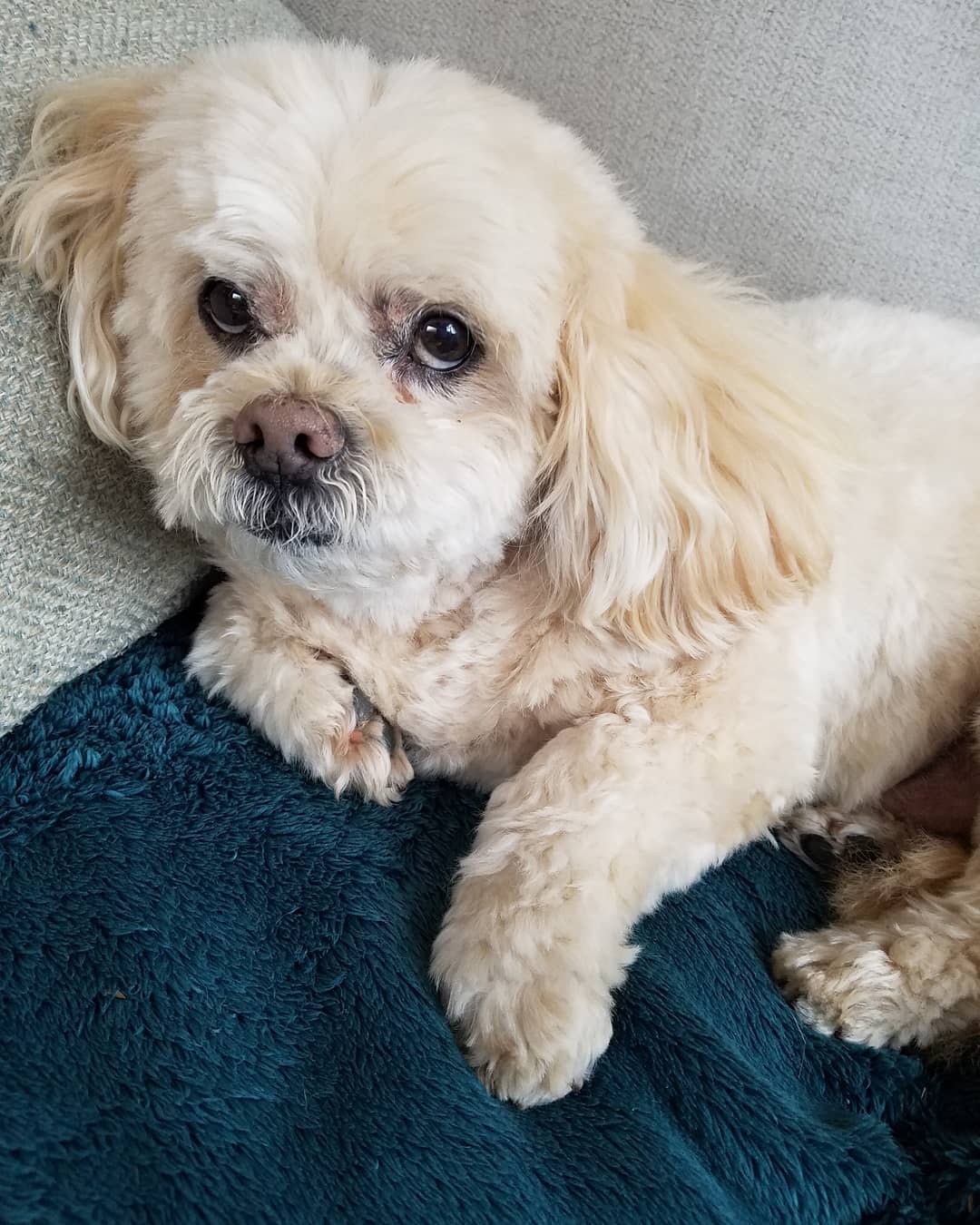
An acceptable diet for the breed can be both “drying” and natural products. The first option is preferred by the owners of show individuals – it is always easier to organize food for a pet using industrial feed when traveling to exhibitions. A natural menu has its advantages since the owner independently controls the quality of the purchased products. The only caveat is the constant need to add purchased vitamins and mineral complexes to the diet to compensate for the lack of nutrients in ordinary food.
Basic ingredients of natural food for Lhasa apso:
- lean meat and liver;
- boiled fish fillets (once a week or less);
- porridge – buckwheat, rice, oatmeal;
- fermented milk products of low-fat content;
- quail eggs;
- greens, vegetables, berries, and fruits (exclude: potatoes, legumes, citruses, grapes).
To improve the condition of the coat, you can add a little vegetable unrefined oil and fish oil to the feed. Useful delicacies include soft cartilage, veins, and other substandard foods. And of course, it is important to remember that from ½ to ⅔ of a dog’s portion is always meat, and only the rest comes from cereals and vegetable additives.
Lhasa apso is notable for good health, but even this fact does not guarantee that the dog will definitely live through the years allotted to it, never getting sick. Ailments that can be identified in the breed:
- von Willebrand disease;
- distichiasis;
- dislocation of the knee caps;
- progressive retinal atrophy;
- dysplasia of the joints;
- hypoplasia;
- urolithiasis disease.
The head of the Lhasa apso, although not as flattened as that of the Shih Tzu, still has a brachycephalic type of structure. This means that occasionally the animal may experience shortness of breath and difficulty breathing.
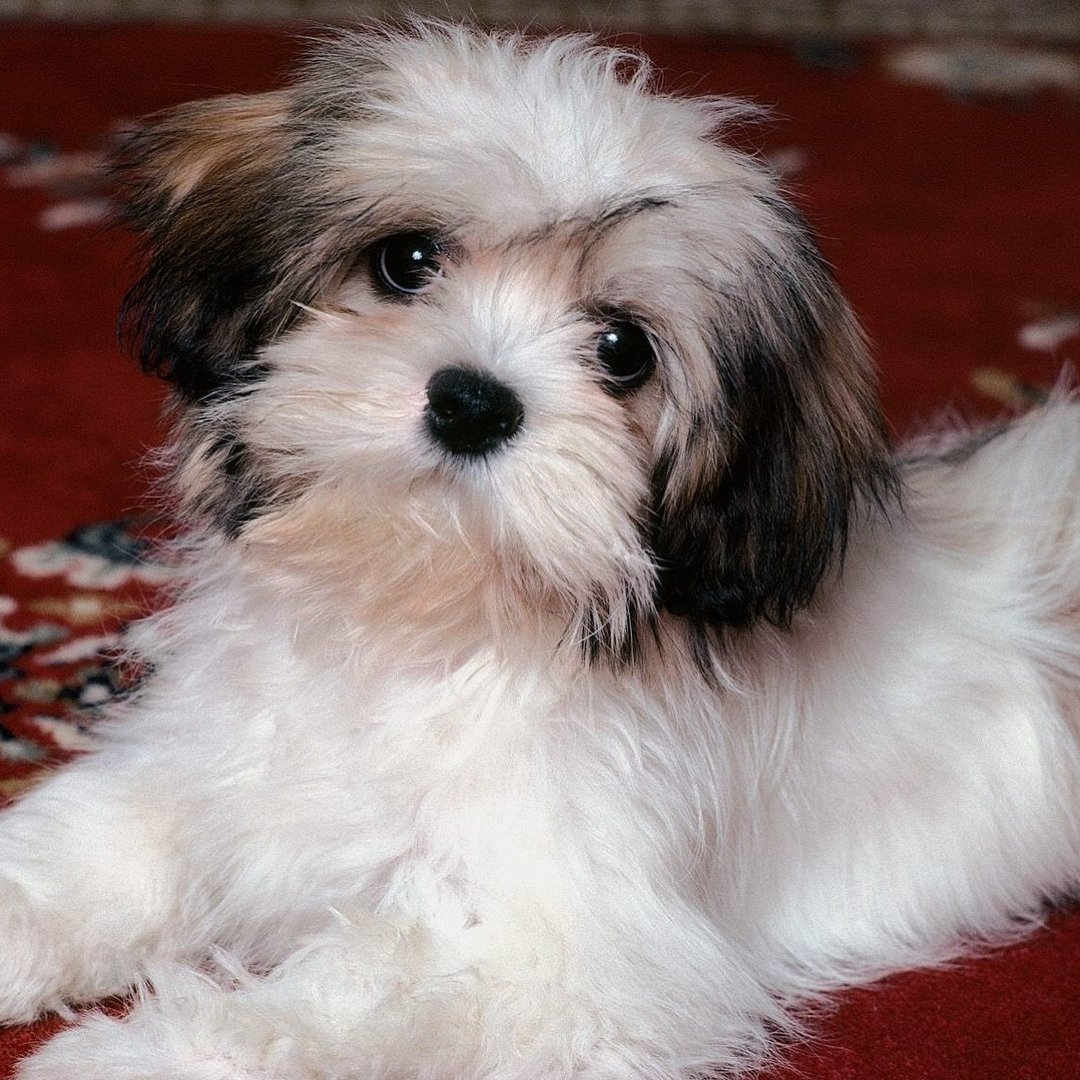
How to choose a puppy?
- If you are planning to purchase a pair of puppies, try to choose a male and a female. Lhasa Apso loves to fight with fellow tribesmen, especially often conflicts occur between same gender individuals.
- For breeding and participation in exhibitions, it is necessary to take puppies not younger than 10 months. In small Lhasa apso, the exterior potential is not fully revealed.
- Even if you are buying a dog exclusively “for yourself”, ask the seller for a puppy metric to be sure that the pet is purebred.
- When choosing a Lhasa Apso puppy by color, keep in mind that as the animal grows up, the coat often fades and changes tone.
- Pay special attention to the size of the dog’s nose. In a three-month-old Lhasa Apso, the length of the muzzle should not exceed 2.5-2.8 cm.
- It is advisable to get to know the breeders of the litter, or at least see their photos. Moreover, it will be better if the breeder provides amateur pictures, and not studio photos, where the pet is perfectly combed, and its exterior defects are masked.
- Examine the puppy you like carefully. The Lhasa Apso breed is bred in several types: some lines are richer and poorer dressed; in addition, some breeders offer babyface puppies that have a more pretty expression on their faces.
- Don’t be seduced by overly soft, fluffy babies. Having matured, such a Lhasa apso will cause a lot of trouble: due to the abundance of downy undercoats, his “fur coat” will constantly fall off.
